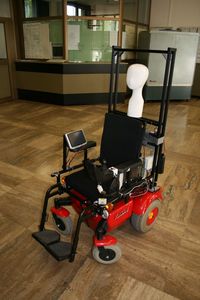Difference between revisions of "AGW"
(Created page with "{{Project template |title=AGW - Automatic Guided Wheelchair |image=http://home.deib.polimi.it/farina/Tesi_file/image010.jpg |tutor=MatteoMatteucci, Marcello Farina, Luca Basce...") |
|||
| (One intermediate revision by the same user not shown) | |||
| Line 1: | Line 1: | ||
| − | {{Project | + | {{Project |
|title=AGW - Automatic Guided Wheelchair | |title=AGW - Automatic Guided Wheelchair | ||
| − | |image= | + | |image=LURCH wheelchair.jpg |
| − | |tutor=MatteoMatteucci | + | |short_descr=Control system design of an electric wheelchair for autonomous drive with obstacle avoidance |
| + | |tutor=MatteoMatteucci; Marcello Farina; Luca Bascetta | ||
| + | |students=MauroGabellone; EugenioCeravolo | ||
| + | |resarea=Robotics | ||
| + | |restopic=Robot development; | ||
| + | |start=2015/11/?? | ||
| + | |level=Ms | ||
| + | |status=Active | ||
| + | |type=Thesis | ||
}} | }} | ||
The goal of this master thesis project is to take over the control of a wheelchair (designed to be controlled through a lever) in order to make it an autonomous vehicle. | The goal of this master thesis project is to take over the control of a wheelchair (designed to be controlled through a lever) in order to make it an autonomous vehicle. | ||
| − | The first stage will concern the identification of the system, which will provide the relation between the control input (lever position) and | + | The first stage will concern the identification of the system, which will provide the relation between the control input (lever position) and wheels actuators. |
| − | The project will be carried out step by step: as a first | + | The project will be carried out step by step: as a first stage, the control will merely involve trajectory generation and following (by means of Model Predictive Control algorithms). Then, obstacles will be placed in the environment and the control problem will focus on obstacle avoidance (either fixed or moving). |
Two kinds of sensors will be available: a camera sensor (which will provide almost deterministic measurements) will be used in the first stages of the project, while two laser sensors (and their stochastic measurements) embedded on the wheelchair will be used in the latter stages as a more realistic scenario. | Two kinds of sensors will be available: a camera sensor (which will provide almost deterministic measurements) will be used in the first stages of the project, while two laser sensors (and their stochastic measurements) embedded on the wheelchair will be used in the latter stages as a more realistic scenario. | ||
The purpose is to design a robust control system which would take care of the passenger comfort and energetic optimization given the task to be carried out. | The purpose is to design a robust control system which would take care of the passenger comfort and energetic optimization given the task to be carried out. | ||
Latest revision as of 19:52, 10 November 2015
AGW - Automatic Guided Wheelchair
| |
| Short Description: | Control system design of an electric wheelchair for autonomous drive with obstacle avoidance |
| Coordinator: | |
| Tutor: | MatteoMatteucci (matteo.matteucci@polimi.it), Marcello Farina (), Luca Bascetta () |
| Collaborator: | |
| Students: | MauroGabellone (mauro.gabellone@mail.polimi.it), EugenioCeravolo (eugenio.ceravolo@mail.polimi.it) |
| Research Area: | Robotics |
| Research Topic: | Robot development |
| Start: | 2015/11/??warning.pngThe date "2015/11/??" was not understood. |
| Status: | Active |
| Level: | Ms |
| Type: | Thesis |
The goal of this master thesis project is to take over the control of a wheelchair (designed to be controlled through a lever) in order to make it an autonomous vehicle. The first stage will concern the identification of the system, which will provide the relation between the control input (lever position) and wheels actuators. The project will be carried out step by step: as a first stage, the control will merely involve trajectory generation and following (by means of Model Predictive Control algorithms). Then, obstacles will be placed in the environment and the control problem will focus on obstacle avoidance (either fixed or moving). Two kinds of sensors will be available: a camera sensor (which will provide almost deterministic measurements) will be used in the first stages of the project, while two laser sensors (and their stochastic measurements) embedded on the wheelchair will be used in the latter stages as a more realistic scenario. The purpose is to design a robust control system which would take care of the passenger comfort and energetic optimization given the task to be carried out.
